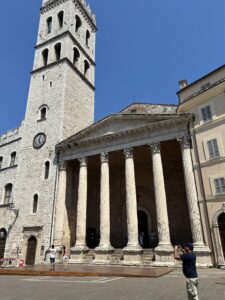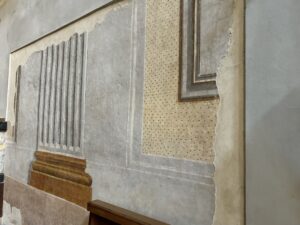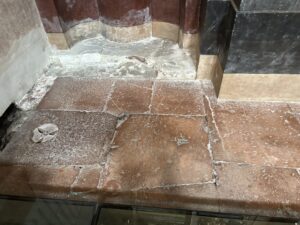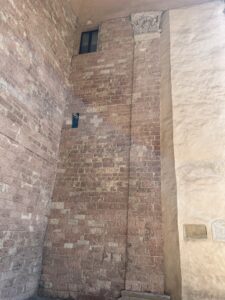Edward Gibbon famously wrote: “It was at Rome, on the 15th of October 1764, as I sat musing amidst the ruins of the Capitol, while the barefooted friars were singing Vespers in the temple of Jupiter, that the idea of writing the decline and fall of the City first started to my mind.” This is generally seen as somewhat fanciful as a recollection. But it is undoubtedly resonant, and of course all over the former Roman world buildings were re-used and converted to other purposes. One suspects that Roman ruins exerted a powerful impact on the minds of later civilisations. Close to home in Edinburgh, the medieval foundation of Cramond Kirk stands in the remains of the Roman Fort guarding a harbour not far from the eastern end of the Antonine Wall.
These thoughts are prompted by a very recent visit to Assisi, where the Basilica of St Francis of Assisi has been restored after the major earthquake of 1997. The attractive walled city was busy, unpleasantly so, with tourists and pilgrims, no doubt as part of the build-up to the canonisation of Carlo Acutis, whose body lies in a glass tomb in the Basilica of St Francis. The canonisation took place on 7 September at St Peter’s Basilica in Rome.
Gibbonian reflections were prompted, however, in the Piazza del Commune, by the presence of the imposing façade and portico with triangular pediment of the Roman temple of Minerva (there is some variation in view). Goethe visited it specially in 1786, impressed by the best preserved monument of antiquity he had ever yet seen. He thought it not worth his time to visit the Giotto frescoes in the Basilica of St Francis: it was the classical not the medieval world that interested him. The Temple has had a complex history. In the Middle Ages, the cella had been a church devoted to San Donato. Later it was the tribunal and prison, and in 1539 it was converted into a Christian Church on the instruction of Pope Paul III (Assisi was part of the Papal States).
The Piazza may have been the Roman forum; or it could have been a religious centre.
But the interesting thing is that they remained as a centre of administration and law: continuity is powerful in the world.






